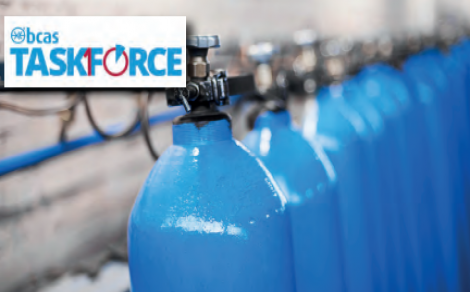Maintenance tips for compressed air system efficiency

In April last year, the British Compressed Air Society (BCAS) launched the 10% Taskforce - a call for UK businesses to take simple steps to cut their compressed air energy usage figure by 10%.
The campaign has an ambitious target to save over 411 thousand tonnes of CO2, the equivalent of taking 317 thousand cars off the road.
When BCAS launched the campaign, no one could have predicted the scale of the rise in the wholesale gas and electricity prices. The campaign’s original calculations of £485.43 million being spent in wasted electricity have now risen two or even three-fold.
Generating compressed air can be very energy intensive, representing as much as 30 per cent of a site’s total electricity bill. According to a report entitled ‘Compressed Air Systems in the European Union’1, when looking at the most important energy savings techniques available to compressed air users, ‘the energy savings amount to 32.9%, achievable over a 15-year period.’
Therefore, since the launch, BCAS members have been speaking with customers to encourage them to act and to dispel some of the commonly held beliefs that saving energy will require significant investment in new capital equipment.
In particular, the Society is advocating small, incremental steps and demonstrating the significant impact these can have on reducing energy consumption. This can include better housekeeping routines to avoid wasteful practices, fixing air pipework leaks, recovering heat which would otherwise be lost to the atmosphere, or implementing routine system maintenance.”
Ongoing compresed air maintenance
With compressors accounting for a considerable amount of the energy used by industry, users will be looking closely at ways to reduce electricity consumption from their compressed air production.
A good place to start is to consider the ongoing maintenance of the compressed air system. Long running hours and harsh operating conditions can all contribute to higher costs – and greater wear and tear. Maintaining the system correctly will guarantee reliable operation, while also ensuring improved energy performance.
To begin with, operators should use a skilled maintenance professional. BCAS members for example, are trained to maintain compressors, downstream and ancillary equipment to ensure the system is running as smoothly as possible as part of a planned, proactive or predictive maintenance plan.
Keep it cool
Compressors should be positioned in a dry, clean and cool location with good ventilation. This will ensure that the compressor room is as close to ambient temperature as possible.
More energy is required to compress warm air, but some compressor plant rooms will run at temperatures as high as 30°C. When temperatures reach this level, it can result in more frequent compressor downtime, alongside higher energy consumption, leading to a less efficient system.
System first approach
Although a compressed air system is a sophisticated piece of engineering design, in its basic form it is a ‘system’. All systems require regular maintenance to help ensure performance is maximised.
Operators should inspect the system regularly for air leaks in the pipework, as even the smallest leak can lead to significant energy loss, alongside an action plan to fix any leaks as they occur. Users should add this to the site’s weekly maintenance regime for improved functionality. It is also important to check inlet filters and replace routinely to avoid pressure drops, alongside any ancillary equipment including dryers, filters, pipework and air receivers.
Regular maintenance
The final step is to ensure the system is maintained regularly to run at optimum efficiency. It is about being ‘proactive’ rather than ‘reactive’ in regards to a machine breakdown, identifying potential problems before they become major concerns.
In addition, BCAS recommends using genuine manufacturer’s spare parts for the compressed air system. These will have been designed for the specific compressor, so will offer the best performance over other alternatives, helping to avoid unintentionally downgrading the system. Choosing genuine spare parts will also help to save time and money, as lower quality or inferior parts could lead to equipment failure and increased energy consumption.
The benefits
The benefits of a full and effective maintenance regime are many and varied. The system should function much more efficiently, helping to avoid unplanned outages and downtime.
And of course, by putting a maintenance plan in place, unnecessary energy loss through poorly performing equipment can be avoided, helping combat rising energy costs. Operators can also be confident that the compressed air system is performing to the best of its ability, freeing up more time to prioritise other energy saving measures.
For more information, please speak to a BCAS member who can assist in this area by emailing enquiries@bcas.org.uk or visit: www.bcas.org.uk
1Compressed Air Systems in the European Union. Energy, Emissions, Savings Potential and Policy Actions. Peter Radgen and Edgar Blaustein (Editors: Note that the potential for savings is less than the sum of the savings for individual measures. The total possible savings must be calculated as a product of efficiency gains. It should be considered that the efficiency gain of each measure acts on the residual compressed air system energy consumption
For further information please visit: www.bcas.org.uk
Tel: 020 7935 2464 e-mail: info@bcas.org.uk
https://www.linkedin.com/company/british-compressed-air-society/
-
Smart Manufacturing & Engineering Week
05 - 06 June, 2024
NEC, Birmingham -
HILLHEAD 2024
25 June, 2024, 9:00 - 27 June, 2024, 16:00
Hillhead Quarry, Buxton, Derbyshire UK










